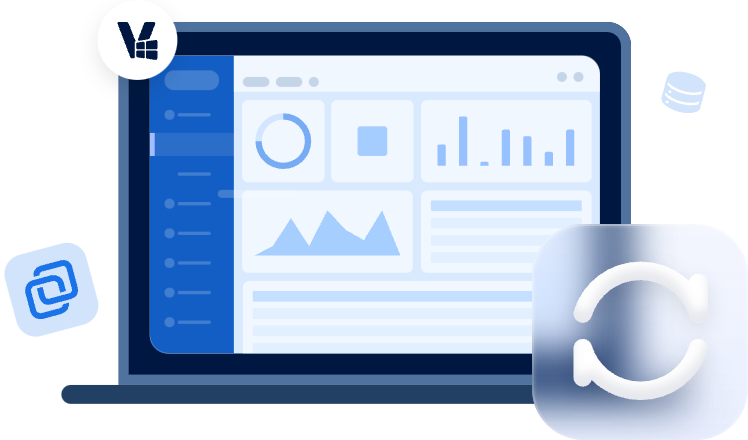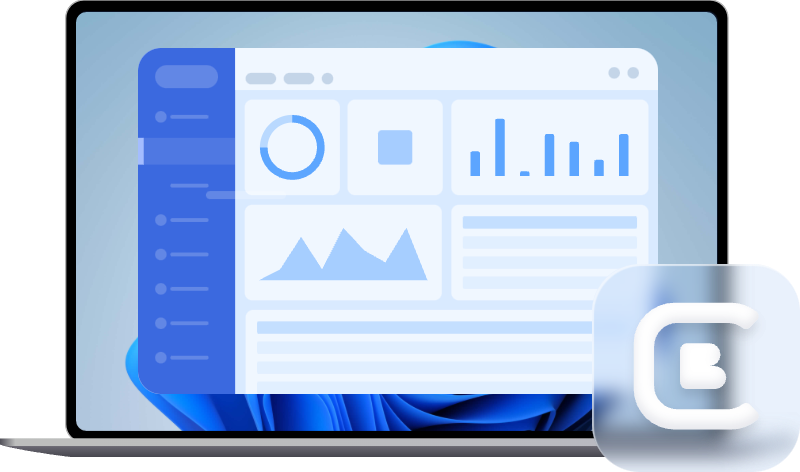Best Endpoint Backup Solution for Windows PCs and Servers
Endpoint backup is a particularly suitable concept for enterprise environments, which can protect all the endpoints data on the network. Keep reading to pick the best endpoint backup solution and learn the step-by-step guide.
What is endpoint backup and why is it required?
Endpoints refer to the physical devices connected to a computer network. Take an enterprise environment as an example, the computer used by each employee is an endpoint. So endpoint backup is to copy data on endpoints, such as laptops, desktops, servers, and virtual machines. Once you encounter a data disaster or a device issue, you can easily restore data from the endpoint backup.
Especially for enterprises, an excellent endpoint backup solution is important. It protects all the devices in the network and safeguard business from all threats. More specifically, you can enjoy the peace of mind from these aspects:
◆ Automatically secure critical data and reduce downtime in the event of a disaster.
◇ Easily recover endpoint devices and retrieve all the data during a system breakdown.
◆ Backup and restore all network endpoints from one central console to reduce IT burden.
◇ Segment enterprise endpoints into different groups and enforce different protection policies.
◆ Real-time monitor endpoint device conditions and backup task execution status...
So, how exactly do you implement endpoint backup solutions, and what to consider about it?
Best enterprise endpoint backup software with centralized console
The most common operating system in enterprise is Windows. Both Windows client OS and Server OS come with some backup solutions such as File History, System Image Backup, Windows Server Backup, etc. However, if you rely on each employee to perform backups on their own, it will be very inefficient and may cause more human errors.
A more efficient way is for administrators to centrally back up and manage all enterprise devices using professional endpoint backup solutions. Here I’d like to introduce you AOMEI Cyber Backup, which can back up all the enterprise endpoints (laptops, desktops, servers) on the network efficiently.
👉With it, you can enjoy comprehensive and centralized backup features:
◆ It supports System Backup, Disk Backup, Partition Backup. You can choose a backup type based on your needs.
◆ Scheduled/automatic backup. Automatically run backup tasks in the background by customizing the backup schedule, eliminating the need to set up a backup task each time.
◆ Backup to All locations. You can save your backup to local storage, external drive, NAS drive. And you can archive your backup to cloud storage like Amazon S3.
◆ When restoring an endpoint backup, you can choose which backup point, which full, incremental or differential backup to restore from. You can also perform in-place recovery, or restore to another endpoint on the network.
This software could be installed on any computer running Windows 11, 10, 8, 7, Vista, XP, or Windows Server 2022, 2019, 2016, 2012(R2), 2008(R2), etc as the central console, from where you can gain control over client PCs or servers in the LAN for backup and monitor.
Download this 30-day free trial to experience the all-in-one endpoint protection:
How to perform endpoint backup with AOMEI Cyber Backup
Here I will show you how to implement an endpoint backup solution with this enterprise endpoint backup software.
Step 1. Install AOMEI Cyber Backup agent
Install AOMEI Cyber Backup on a computer and run. Login in. The default username and password are both "admin". Click "Source Device" >"Agents". You’ll see two options as follows:
• Manual Client Installation: Click "Download Agent" to download the installation file, and copy it to all endpoints that need to be backed up for installation.
• Remote Client Installation: Click "Add Agent". Enter the IP address and the Windows login information that you’d like to back up.
Step 2. Create Backup Task
Click Backup Task on the left pane > Click Create New Task. Choose a backup type, backup content, device name, and other information.
Add a backup location to save your endpoint backups. You can choose a local storage, external hard drive, NAS drive, etc.
Tip: If you need to save backup on a cloud space, enable the Archive feature and add an AWS S3 storage. Then archive your endpoint backup to it.
Here you can set up a backup schedule. You can run full backup, incremental backup, and differential backup daily, weekly or monthly.
Step 3. Start Backup and Wait for Completion
Click the “Start Backup” button. And subsequent backup will execute automatically according to the schedule you set.
Further thoughts on enterprise endpoint backup (4 useful tips)
The above sections provide an endpoint backup solution that you can easily use, along with specific steps to follow. But there are actually many factors to consider in actual endpoint protection. I've compiled some of the relevant information here.
Tip 1. On-site backup vs off-site backup
Onsite backup refers to storing data on local devices such as internal/external drives, CDs, tapes, etc. Off-site backup refers to storing data on off-site servers that can be accessed via the Internet. Both of the two have their advantages & disadvantages and are more recommended to be used in combination according to 3-2-1 backup strategy.
The endpoint backup software introduced in this article enables you to back up endpoint data to NAS or a remote server (via network share). For example, you can either create a shared folder on an external hard drive or another computer on the network as backup destination. With offline files enabled, these backup files can be accessed even when the server is slow, not connected or unavailable.
Meanwhile, if you want to perform off-site backup to cloud as well, you can combine other backup freeware that can utilize cloud storage, such as AOMEI Backupper Standard.
Tip 2. Proper choice of backup types
When we talk about backup types in a general sense, we usually mean full, incremental and differential backup. Sometimes mirror backup is also counted as the 4th type.
The way these types work is completely different, simply put:
- Full backup will create a complete backup of all data in the specified directory. Every time you execute it, you will repeat this backup progress indiscriminately.
- Incremental backup will create a full backup at the first time, and back up only changed data compared to the last backup in every subsequent backup.
- Differential backup is similar to incremental, but it will back up all the changed data since the last full backup.
Here is a table that visually compares the performance of the three:
|
|
Full Backup |
Incremental Backup |
Differential Backup |
|
Backup Speed |
Slowest |
Fastest |
Slower |
|
Restore Speed |
Fastest |
Slowest |
Slower |
|
Restore Items |
Any full backup |
Last full backup and all linked incremental backup. |
Last full backup and or one of differential backup |
- Mirror backup is a little more different from these three as it is strictly a synchronization. It will synchronize the files added and modified in the source directory to the target directory so that the files in the target directory are always identical to those in the source directory. Files in the target directory that do not match the source directory will be deleted or overwritten.
AOMEI Cyber Backup supports all these backup types and you can choose according to your needs.
Tip 3. Reasonable backup schedule
There are many different types of data in an enterprise and different business may be loaded on different endpoints. Therefore, creating only one schedule for all devices may not work very well. You can arrange the backup task more flexibly based on the following rules.
- Create more versions of backups for critical data
It is best to create different backup plans based on the importance of the data and how often it is changed, so that critical data can be restored on demand in the event of a disaster.
- Schedule backups wisely
It is best not to schedule full backups of large data during work hours. If you must back up during the workday, choose to perform incremental backups during the day and run full backups at night.
Tip 4. Hot backup and cold backup
A hot backup is a backup performed while users are still logged into the system, while a cold backup is performed while all users are offline. Obviously, performing a hot backup minimizes daily downtime, which is especially useful for endpoints that require 24/7 operation.
AOMEI Cyber Backupper enables you to backup any open files and running programs without termination, and the backed-up endpoints will not be interrupted.
However, hot backups are not flawless. If any data changes during the course of a hot backup, then it may result in inconsistencies where the files being backed up are not up to date. In addition, backups are bound to take up computer resources, so the performance of the machine and server may be affected during the backup.
That said, if the endpoints you are backing up have extremely high requirements for data consistency and system performance, then it is best to perform backup during non-working hours.
Conclusion
This article introduces what is endpoint backup and the best endpoint backup solution for PCs and Servers - AOMEI Cyber Backup. Once encountering a data disaster or a device issue, you can quickly still keep your important data.
Besides, as a professional enterprise backup software, AOMEI Cyber Backup also supports backing up more critical data and information. for example, you can backup VMware virtual machines, Hyper-V virtual machines, and SQL databases.






